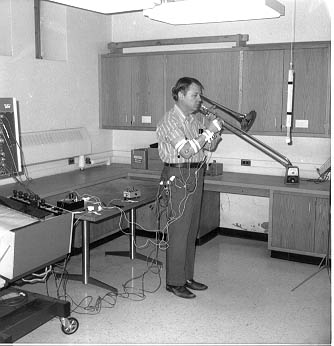|
A team of researchers at Gustavus Adolphus College in Saint Peter, Minnesota
has been exploring ways in which scientific observation can be used to
advance musical pedagogy for more than 20 years. The core of the team
consists of a psychologist, Dr. Mark Kruger and a musician, Dr. Mark Lammers.
Over the years we have been joined by members of the Physics faculty at
Gustavus (and recently at SUNY-Geneso), members of the Music and Psychology
Departments at Gustavus, and two kinesiologists from the University of
Minnesota. Recently, Dr. Jon Kruger, Department of Fine Arts, Rochester
Institute of Technology has begun to work closely with us. The evolution
of the team came as a result of work done by the musician, the psychologist
and one of the kinesiologists (Dr. Lela Stoner) over a period of years
which focused on the right arm of trombone players. In 1993 the team was
expanded when they were awarded a National Science Foundation Grant to
continue the study. Several studies have been conducted on the right arm
of trombone players. The first was done in 1981 and reported in 1983 (Lammers,
1983) involving fourteen trombonists. Seven of the subjects were professional
players and seven were college student performers. Electromyography (EMG)
and electrogoniometry (ELGON) were used in that first study. The muscles
studied using EMG were the biceps and triceps of the upper arm and the
extensor and carpi radials of the forearm. The electrogoniometers used
were single plane instruments that measured flexion and hyperextension
of the wrist and the angle of the elbow Because the findings in the first
study involving the electrogoniometer at the wrist were inconclusive,
a second study was done at the Mayo Clinic in Rochester, Minnesota in
1987 (Lammers & Kruger, 1991). An orbital electrogoniometer was used
to measure both hyperextension-flexion and abduction-adduction of the
wrist. Ten student trombone players were the subjects. A third study involved
ELGON, videography (both fast and slow speed) and a range finder called
sonic ranger. Forty-two subjects were studied ranging from sixth graders
to professional trombonists. Data has been collected at the University
of Minnesota and at Gustavus Adolphus College. The results support the
hypothesis that professionals move more quickly from position to postion
and that movement of the wrist is an integral part of the motion of the
right arm. Since these initial studies, we've gone on to look at the performance
of beginning trombone students, to examine the extent to which pedagogical
materials on slide placement correspond to slide movement of performing
trombone players and to examine differences in the errors made by players
as a function of expertise. A highlight of this work was our invitation
to give an address to the The Physics Congress in Brighton, England in
March 2000. Recently, we've expanded our interests to the practice habits
of all applied music students, to trumpet and horn performance, and to
understanding the impact of autobiographical memories of musical experiences
on orchestral musicians and their audiences.

|

